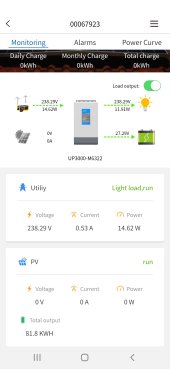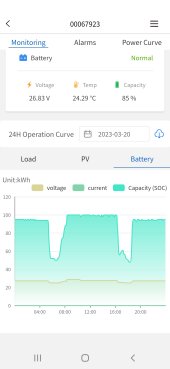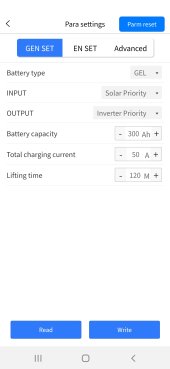Viem, že ten tvoj je trochu iný.
Nezmení to základné kroky na riešenie problémov, ani to, prečo väčšina hybridov používa hlasné 80 mm ventilátory (poskytujú vysoký statický tlak)
Ak chcete vedieť, ako a prečo, musíte odstrániť akékoľvek „navyše“.
Základnou funkciou je tepelná energia zo solárneho panelu a uloženie alebo premena tejto energie.
As you don't start with a fully charged battery, that's step one.
Just solar and battery.
When that works OK, , convert to AC.
When that works OK, start with charging / providing energy via grid.
After all this works OK, start playing with scheduling.
Of you like to do all at once, up to you.
Just don't ask the question "why".
As trouble shooting, working step by step slowly increasing complexity will reveal where things go "strange".
Without those steps you won't be able to answer the "Why".
It already started with the battery and the charge settings.
Is it lead acid?
Is it lithium?
If it is lithium, is it S15 or S16 as standard charge cycle setting?
Way too little information to provide any answers.
I understand you like a "quick fix"
And you might get a lucky hit via trial and error. Then it might work.
Stále nedostanete odpoveď na otázku prečo.
Silent wings 3 120 PWM vysoká rýchlosť je 25-30 $ za 1 ventilátor.
Potrebujete minimálne 2.
Použil som 4 v konfigurácii push pull, jednu sadu napájanú hybridným meničom, jednu sadu cez externý zdroj energie.
Stratil som pár meničov kvôli zlému tepelnému manažmentu, takže neriskujem.
Ventilátory vydržia o desaťročia dlhšie ako striedače...
Ale je to dodatočná investícia.
Teraz si môžete oddýchnuť na niekoľko metrovej vzdialenosti, pričom invertor a solárna energia pracujú na špičkovom výkone

predtým? Potrebujete ochranu sluchu...
(Bez srandy)





